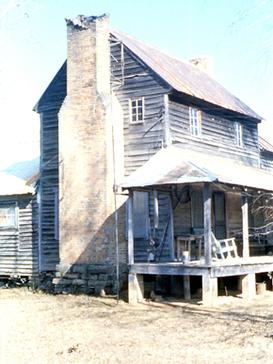
Anson County is a county located in the U.S. state of North Carolina. As of the 2020 census, the population was 22,055. Its county seat is Wadesboro.

Wadesboro is a town and the county seat of Anson County, North Carolina, United States. The population was 5,049 at the 2020 census. The town was originally found in 1783 as New Town but changed by the North Carolina General Assembly to Wadesboro in 1787 to honor Colonel Thomas Wade, a native son, state legislator, and Revolutionary War commander of the Anson County Regiment.

The Blount Mansion, also known as William Blount Mansion, located at 200 West Hill Avenue in downtown Knoxville, Tennessee, was the home of the only territorial governor of the Southwest Territory, William Blount (1749–1800). Blount, a Founding Father of the United States, a signer of the United States Constitution, and a U.S. Senator from Tennessee, lived on the property with his family and ten African-American slaves. The mansion served as the de facto capitol of the Southwest Territory. In 1796, much of the Tennessee Constitution was drafted in Governor Blount's office at the mansion. Tennessee state historian John Trotwood Moore once called Blount Mansion "the most important historical spot in Tennessee."
Little House may refer to:

Hoyt Patrick "Pat" Taylor Jr. was an American politician and attorney who served as Speaker of the North Carolina House of Representatives and as the 26th Lieutenant Governor of North Carolina.

Liberty Hall, also known as the Governor William Livingston House, located on Morris Avenue in Union, Union County, New Jersey, United States, is a historic home where many leading influential people lived. It was documented by the Historic American Buildings Survey (HABS) in 1938. The house was added to the National Register of Historic Places as a National Historic Landmark on November 28, 1972, for its significance in politics and government. It is now the Liberty Hall Museum.
The term boggan may refer to:
Hammond House may refer to:

The Wadesboro Downtown Historic District is a 32-acre (13 ha) national historic district located at Wadesboro, Anson County, North Carolina. It included 81 contributing buildings, one contributing structure and one contributing object in the governmental and commercial core of the City of Wadesboro. It includes work by architects Wheeler & Stern. Notable buildings include the Anson County Courthouse (1914), U.S. Post Office, the Boggan-Hammond House and Alexander Little Wing, the Burns Inn, Parsons Pharmacy, Leak's Hardware Company Building, and the Ansonia Theater.

The Gilchrist House was a historic farmhouse near Cordova in Walker County, Alabama. Built when Alabama was still a part of the Mississippi Territory, it was considered by architectural scholars as one of the oldest surviving houses in Alabama and the oldest structure in the central and western area of the state. It was added to the National Register of Historic Places on March 24, 1972. It was destroyed by fire during the late 1990s, but the site remains listed on the National Register.
Anson County Schools is a PK–12 graded school district serving Anson County, North Carolina. Its 11 schools serve 3,845 students as of the 2010–2011 school year.

United States Post Office is a historic post office building located at Wadesboro, Anson County, North Carolina. It was designed by the Office of the Supervising Architect and built in 1932–1933. It is a two-story rectangular building of cream brick with limestone trim in a Classical / Colonial Revival style. Five central bays of the front facade make up a slightly projecting frontispiece defined by an arcade of six colossal stone pilasters with Greek corinthian order capitals.

Sheriff Stephen Wiley Brewer Farmstead, also known as the Regan Property, is a historic home and farm located at Pittsboro, Chatham County, North Carolina. The main house was built about 1887, and is a two-story Italianate / Queen Anne style gable-and-wing frame dwelling. It features a gabled wing with one-story bay window and a one-story porch across the main block. Also on the property are the contributing original granary and smokehouse.

Railroad House is a historic home located at Sanford, Lee County, North Carolina. It was built in 1872, and is a 1+1⁄2-story, three bay, board-and-batten, Gothic Revival style frame cottage. The gable roof has wide overhanging eaves and "rafter brackets." It has a one-story rear wing, a single central interior chimney in the main block, and an exterior end chimney at the rear of the wing. It was built by the Raleigh and Augusta Air Line Railroad for the depot agent. The house was moved to its present site in October 1962, across the street from its original location. The building is operated by the Railroad House Historical Association as a museum.

Dortch House is a historic home located in Dortches, North Carolina, Nash County, North Carolina. It was built about 1803, by William Dortch, and is a Federal-style frame dwelling that consists of a two-story, three-bay, main block covered by a gable roof and a one-story rear wing. It is sheathed in weatherboard and features a one-story full-width front porch and Palladian windows. The house was purchased by Henry Griffin in 1899 from the Dortch family and remained in the Griffin family until 2020. The one-story full-width front porch was added by the Griffin family sometimes before the 1910s. A one-bay portico with columns was the original porch to the house.

Faucett Mill and House, also known as Coach House and Chatwood, is a historic grist mill, home, and national historic district located near Hillsborough, Orange County, North Carolina. The mill was built before 1792, and is a 2+1⁄2-story, heavy timber frame, weatherboarded building. It is sided alongside a reconstructed mill race and the Eno River. The Faucett House was built about 1808, and is a 2+1⁄2-story, Federal style frame dwelling, with an original one-story rear wing. The house's southwest wing was originally a separate dwelling known as the Naile Johnson House. It was added to the Faucett House about 1938. Also on the property are the contributing mill cottage, barn, and a section of the "Great Road."

Nash Law Office is a historic office building located at Hillsborough, Orange County, North Carolina. It was built in 1801, and is a small one-story, frame building with a gable roof and low brick foundation. It has a brick exterior end chimney and a small one-story wing added in 1865. The building housed the law office of jurist Frederick Nash (1781-1858). Following his death it housed a school and was purchased by the Hillsborough Historical Society in 1970.

Westview Cemetery is a historic cemetery in Wadesboro, North Carolina. Located on the west side of the town, south of Henry Street and west of Madison Avenue, it is a 5-acre (2.0 ha) parcel, which has historically been used as the burying ground for the community's African-American population. The central portion, about 1 acre (0.40 ha) in size, was the original burying ground laid out in 1898. The only burials known to be of whites are those of the Smith family, whose older family cemetery formed part of the original acquisition.

Historic Wolcott House is a historic home located at Wolcott, White County, Indiana. It was built about 1859 by Anson Wolcott the founder of the town of Wolcott. It is a two-story, Italianate style wood-frame building with a rectangular wing. It sits on a rubblestone foundation and has a [wood shake] hipped roof. It was home to three generations of the politically prominent Wolcott family. The Anson Wolcott Historical Society is the caretaker of this beautiful historic home.
Thomas Wade (1720–1786) was a merchant, commander of the Anson County Regiment of North Carolina militia during the American Revolution, and senator from Anson County in the North Carolina Provincial Congress and General Assembly. Wadesboro, North Carolina was named for him.





















